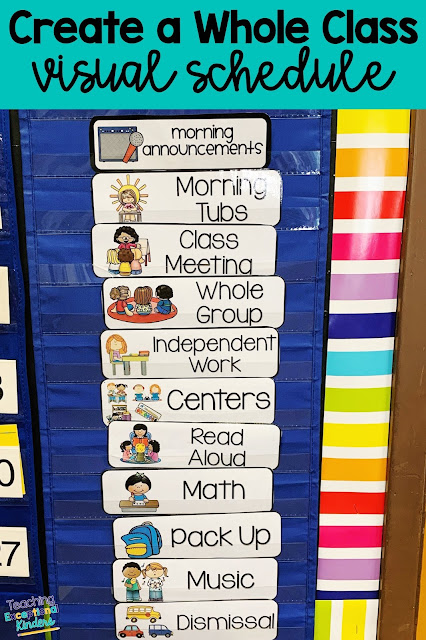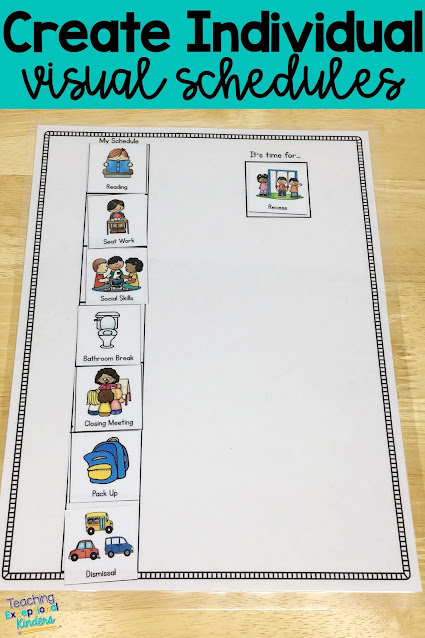Menu
How to Use Visual Schedules to Help All Students to Be Successful in the Elementary Classroom
Facebook
Twitter
Pinterest
Email
Looking for a way to streamline your classroom management and keep you and your students on task throughout the day? A class visual schedule is a simple and very effective tool for teachers to use to support all the students in an elementary school classroom. Posting a daily visual schedule in your classroom can go a long way to calm an anxious student and can help students who have trouble transitioning between jobs to feel more comfortable. Using a class schedule helps non-readers, ELL students and students in need of special education to know or anticipate what is coming next.
When used consistently, a daily schedule can provide visual support, predictability, and structure that many students need to feel successful at school. Teachers can use something as simple as a few picture cards to completely change the flow and organization in their classrooms. The best part is that schedules are pretty easy to create and simple to implement!
Using a Class Visual Schedule
A visual schedule is a simple way to provide the consistent structure your students crave. It can also be a great way to keep yourself on track, too. The days’ tasks are not a secret but rather a should be predictable and routine schedule. Using kid-friendly visuals will help all students. When students are familiar with the schedule, they will remind you what is coming next. By the end of the year, your students can probably help you to put the schedule up every day. The challenge is putting the time in to create the cards and to be consistent in utilizing the schedule and to be intentional about sharing the schedule with your students.
To prepare a visual schedule, teachers need to consider what subjects and activities they do regularly. For example, a kindergarten teacher will likely need a picture card for read aloud, math, guided reading, phonics, and centers. Teachers will need cards for lunch, recess, special classes, and special events. You can use something simple like a star for special events to cover a wide range of topics. You can take pictures of the students in your class doing these activities, find clip art to use, or even draw pictures (if you’re a better artist than me!) for your schedule cards. In my classroom, I use these class visual schedule cards. This pack even has a few editable cards so you can add your own activities or tasks.
Using Individual Schedules
Some students may need mini-schedules or individual schedules to help to stay on track. These are especially helpful for students with autism or difficulty completing tasks without behavior outbursts. Typically, individual schedules use smaller picture cards that can be moved and manipulated by students as tasks are completed throughout the day. These smaller cards can match the class schedule cards or be more specific to match the needs of your student.
You can print and laminate these cards and put hook & loop (like Velcro) on the back to make them easily used by a student. These schedules do not have to fancy or complicated. A simple strip of Velcro on a piece of paper with a space to put finished jobs is all you need. In the morning, put the student’s activities in order down the strip of Velcro and as the student completes each task, he can move it to the done space. This can be easily linked to a behavior plan or reward chart as tasks are completed. The possibilities are endless!
You can keep individual schedules as simple or as complex as you need. Some students may need mini-schedules throughout the day. Mini schedules help when an icon for library class is not enough. A student may need to see, return book, sit on the carpet, listen to a story, do craft, choose a book, check out a book. First, then charts are also helpful for students who are overwhelmed when looking at the schedule as a long list. If you are interested in creating individual schedules for your students, check out my pack here. Just print, laminate and you’ll be all set!
Something as simple as posting a visual schedule to follow in your classroom can completely change your classroom management. Check out this post to learn more about using visual direction cards with your students. What other ways are you using schedules to support the students in your classroom?
Amy
©2024 | ALL RIGHTS RESERVED
SITE DESIGN BY LAINE SUTHERLAND DESIGNS
SITE DESIGN BY LAINE SUTHERLAND DESIGNS
QUICK LINKS
Menu




